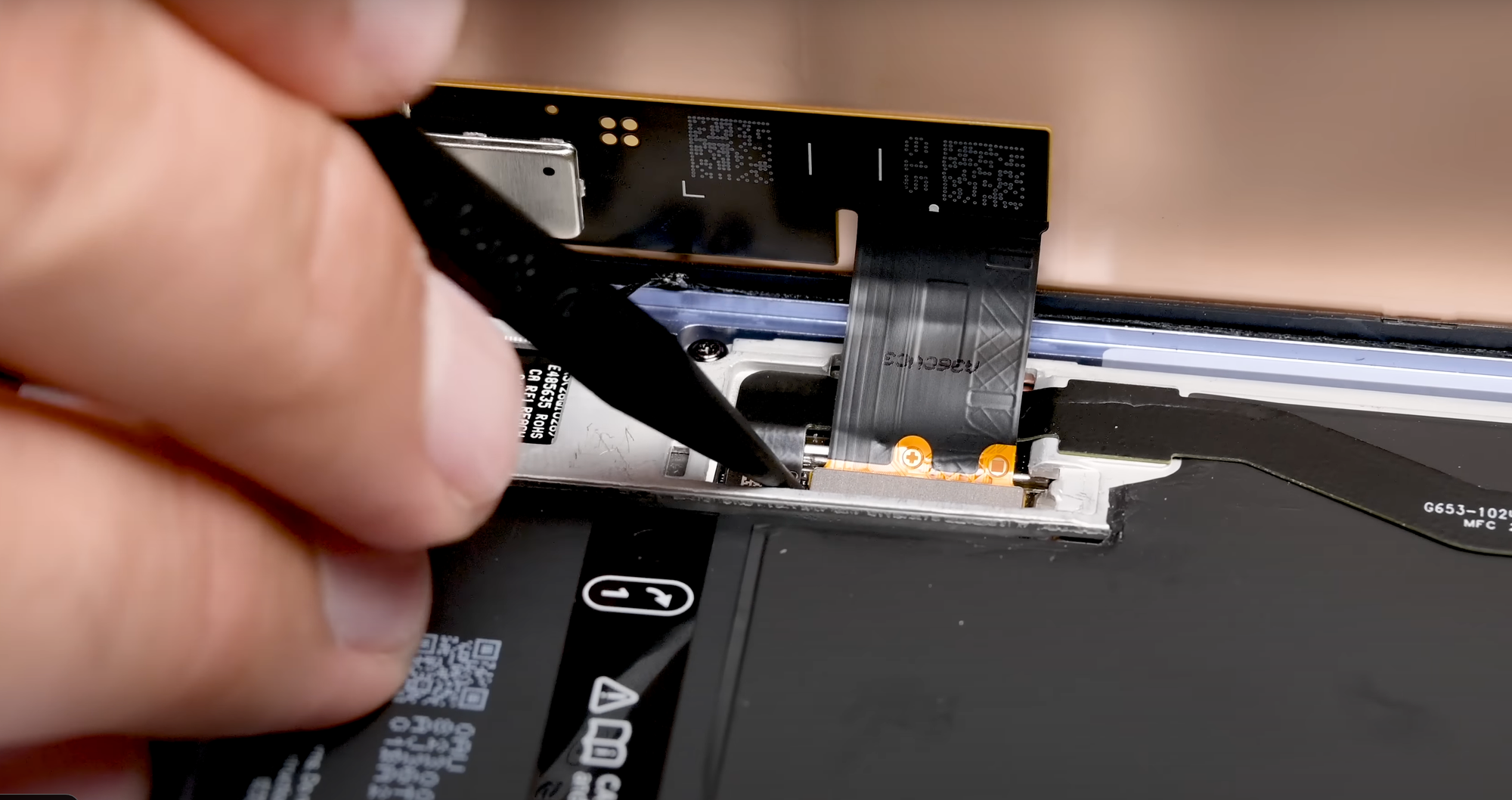Subscribe
Google says that it was moved to support right to repair legislation in part because of widespread demand from its customers and the grassroots right to repair movement, which in a few short years went from being a niche concern to something that is backed by the White House, the Federal Trade Commission, an increasing number of state governments, and some of the companies that once opposed it.
This is a major about-face for one of the largest companies on the planet, which previously opposed right to repair through a series of industry lobbying groups including the Consumer Technology Association and TechNet. It’s hard to overstate how far the grassroots community of independent repair advocates and frustrated consumers have pushed tech giants like Google on this issue. It is one of the rare times where huge numbers of regular people have been able to win a policy battle with manufacturers who have an endless supply of lobbyists, time, and money.
Steven Nickel, Director of Consumer Hardware Operations at Google, told me in a phone interview that, several years ago, he was watching repair and teardown videos by YouTubers after Google introduced some design changes in the Pixel that made it easier to repair.
“What really personally motivated me was going underneath the video and seeing all the comments, which went on and on and on, and were clearly from people who care very deeply about repair,” he said. “And their comments were, ‘Finally someone gets it.’ It was so gratifying to read that, and I shared it with a lot of our internal teams to really reinforce the point that, ‘Hey, look, we’re on the right path. This is the right journey.’ It takes a lot of time to build [a policy] out and to get to a stage where you can publicly talk about it, but that was such a turning point of just, ‘Wow, this has an impact, and this is achieving what we’d really hoped it would with a wide range of people who care about this.’”
I’ve been writing about the right to repair movement for the last nine years, and have been highly critical of companies like Apple, Google, Microsoft, and John Deere who have lobbied against common sense repair laws and regulations, and I have railed against arbitrary DRM and parts pairing that prevents consumers from doing basic repairs on their phones, appliances, or trains. But reporting on this space has shown me that it’s one of the few areas of tech where there has generally been clear and consistent, pro-consumer progress. That’s not an accident. This progress wouldn’t have happened without the constant drumbeat of reporting, criticism, and activism from groups like iFixit, US PIRG, Repair.org, Public Knowledge, and people like Louis Rossmann, Jessa Jones, and, most importantly, the masses of consumers and readers who have continued to fight for the importance of right to repair.
It’s easy to see Google’s decision to support right to repair as a giant company having read the writing on the wall, or seeing incoming regulation and hoping to capture it, or as a cynical move made only after it was clear that right to repair laws would be passed with or without the approval of big companies. It’s easy to look at this and say, “What’s the catch?,” and surely, there will be plenty of more work to be done in this area, and neither this nor any other piece of legislation or decision means that the right to repair fight is over. But I think this is a clear instance of masses of consumers pushing both legislators and companies to create better policies, and should be viewed through that lens.
Google is now lobbying to pass right to repair legislation in Oregon that is stronger than laws passed by New York, Minnesota, and California last year. The Oregon bill deeply restricts “parts pairing,” which is a tactic used by John Deere, Apple, and other major manufacturers that prevent repair parts from working on a device unless they are unlocked by an authorized repair professional, which in many cases is the manufacturer itself. Parts pairing is currently the biggest roadblock to independent repair of many devices; this regime caused iFixit to drastically and retroactively lower its repairability score for the iPhone, for example.
Over the years, it’s been very difficult to get anyone at any major manufacturer to talk about right to repair, so I was excited to get on the phone with Nickel. Here’s my interview with him, slightly edited for length and clarity.
404 Media: I think the most important thing to me is that Google is saying parts pairing should not be allowed. Can you elaborate on Google’s full stance here, including with things like aftermarket parts?
Nickel: It's a critical aspect of repairability and it was something that we encountered as well. We are still in many ways a new entrant in this industry. We've been at it for about seven years. Fairly shortly into it, we recognized that we were going to have a challenge with this. A [repair] part has to communicate with an old existing chassis of the product. So I dropped my phone. I need a brand new screen. It's got to be introduced to the body of that device. They have to connect with each other to recognize each other so that they function properly. And the problem is, you know, even for us at one point, the tools to enable that were internal.
We hadn't really thought about making them available when we ran into this. And so we realized working really closely with our design engineering team, we said, ‘Hey, this really kind of breaks the repair model that we've all aligned on,’ which is consistent with Google's mission of making information useful and accessible. We wanted to make repair useful and accessible. And we said that means we want people to be able to go wherever they want to get repairs. It doesn't have to necessarily be through us. It can be through independent repair providers. And we said, ‘Look, if those repairers put together that screen with that body of that device and it doesn't function, then we're failing at our mission of repairability.’
We work closely with the design engineers. They were able to create a website where you're able to access the tool that you need, a software tool that is simply one connection for that part to recognize the device and vice versa. And then you're set and ready to go and anybody has access to it. It wasn't an insignificant problem to solve.
There’s been a line of attack against repair, used by lobbyists that has been convincing to lawmakers, which is this idea that repair can somehow be insecure. A lot of very good security professionals disagree of course. How does Google think about security and repair, and how will you explain to lawmakers that security and repair don’t necessarily have to be in conflict?
It's something I was deeply concerned about as well. I think inherently there's a concern. I mean, you're not willing to be away from your phone. You're not even willing to give it to a family member a lot of times. And so you're turning it over to a repair technician. You know, we kind of understand the concerns about that, given how much personal information is on a phone. And that's the absolute beauty of Repair Mode of having the confidence to be able to with a simple setting, turn it over and that technician will not be able to see any of that information. And just as importantly, it won't compromise the testing and the suite of testing that they need to do to repair it properly. It makes the argument much easier that repair and security are not mutually exclusive. They can work very well together.
Why do this now, and why Oregon? Why this bill?
It's a very comprehensive bill for exactly the discussion that you and I are having right now. The other bills that we've seen aren't as extensive, especially around the issue of parts pairing. And we felt like, let's start with a comprehensive bill like the Oregon bill is. It's the perfect model and we would offer it up to other states considering repairability and say, ‘Look, this is a very complex subject. Here's a bill where the members involved have had those really difficult discussions that are challenging and have landed on an approach and a vision for what repairability could be.
After Apple endorsed right to repair, a lot of our readers said, ‘OK, what’s the catch?’ And the catch there was that Apple does pats pairing and doesn’t support banning parts pairing. So, is there a catch here with Google?
Look, we want to ensure safe, reliable and efficient repairs. And we are putting in the effort to make sure that that's achievable through the design, through the access to the parts, the manuals. We've done a lot of work redesigning our manuals because we wanted to make sure that they were very user friendly. you want customers to be continuing to work with these devices. They need to function properly and we need to do everything we can to make sure that those repairs are safe, effective, efficient, reliable. But we believe that there's no limit in terms of who can do that if we give them all access to all those materials.
Can you elaborate a little bit on the role that you think that Google customers and the broader grassroots movement played in Google's thinking on this. Has Google heard people complaining and said, ‘OK, we actually can support this?’”
From my side, as a representative of Google's repair operations, we've been doing this since about 2015, if not maybe a little bit before. And it's not an overnight activity. There's so much work and effort to do this properly and effectively. And you certainly don't want to go out and talk about things before they're there fully before, you know, you've made them work properly and effectively and consistently over time.
We look at those comments, they mean something to us and we internalize that we're making products for consumers. And again, it's ultimately about the end user experience.


